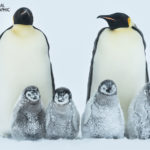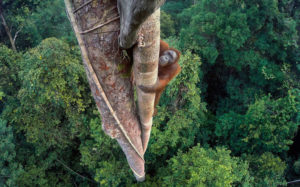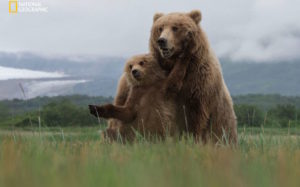
The 2016 National Geographic Nature Photographer of the Year Contest is now well underway. Today, I thought I’d bring you a handful of standout entries in the Animal Portraits category. There are only four categories: Landscape, Environmental Issues, Action and Animal Portraits. The grand-prize winner will receive a 10-day trip for two to the Galápagos with National Geographic Expeditions and two 15-minute image portfolio reviews with National Geographic photo editors.
You only have until November 4th now to submit your photos. Enter before it’s too late!
Above: Two Plus Four 7
Emperor Penguin. Antarctica, On frozen ice.
We were camping on 3m thick frozen sea water, just 1.5 miles away from a big emperor penguin colony, with lots of mega cute chicks. I concentrated especially on taking images of the adorable chicks in the harsh conditions of their environment. The image shows several emperor penguin chicks in front of adult penguins to shield from the forces of the storm.
Photo and Caption by Gunther Riehle/2016 National Geographic Nature Photographer of the Year
Water Drops
Nagano, Japan
The Water Drops of melted snow.
Photo and Caption by Takeshi Marumoto/2016 National Geographic Nature Photographer of the Year
I recently discovered this Tripodfish, Bathypterois grallator, a larval fish during a “black water” scuba diving expedition to document vertical migration marine creatures. This is done in the South Atlantic Ocean, Gulfstream current, The tripodfish or tripod spiderfish, Bathypterois grallator, is a deep-sea benthic fish, known mostly from photographs from submersibles. This fish comes up from the depths of 2,400 feet to 15,000 feet during a vertical migration occurring in the ocean.
Photo and Caption by Suzan Meldonian/2016 National Geographic Nature Photographer of the Year
Ocean Guest
Sleeping walrus on the shore
Photo and Caption by Mike Korostelev/2016 National Geographic Nature Photographer of the Year
Now You See Me
A baby Owlet uses its camouflage to hide from its predators as it spots me from quite a ways away using a focal length of 1600mm by combing a Sigma 800mm with a Canon 2.0 Extender
Photo and Caption by S. Dere/2016 National Geographic Nature Photographer of the Year
Paradise for Flamingoes 2
Thousands of flamingoes live in Bogoria lake where (it’s) likes paradise for them.
Photo and Caption by Yu huiping/2016 National Geographic Nature Photographer of the Year
Dawn Admiring in the Frozen Continent
It was very early in the Antarctic morning and I was walking along the beach admiring the sunrise, then suddenly I had a wonderful surprise: meet this Gentoo penguin (Pygoscelis papua) already looking at the sun that was just on the horizon. At that moment I had the sensation that, like me, he had woken up very early to contemplate such a beautiful dawn. King George Island, Antarctica.
Photo and Caption by Edson Vandeira/2016 National Geographic Nature Photographer of the Year
The Path Less Trodden
A polar bear ekes out a lonely existence in a barren world of ice
Photo and Caption by Harry Lyndon-Skeggs/2016 National Geographic Nature Photographer of the Year


![Tripodfish, Bathypterois grallator, Plankton; larval fish; pelagic larval marine life; vertical migration marine creatures; South Atlantic Ocean, Gulfstream current, The tripodfish or tripod spiderfish, Bathypterois grallator, is a deep-sea benthic fish in the Ipnopidae family found at lower latitudes. It is now relatively well known from photographs and submersible observations, and seem to prefer to perch on the ooze using much elongated fin rays in the tail and two pelvic fins to stand, facing upstream with the pectoral fins turned forward so the outthrust projecting fin rays resemble multiple antennae, and are indeed used as tactile organs. B. grallator is hermaphroditic. At least 18 species are placed in the genus Bathypterois, several of which have similar appearance and behavior to B. grallator. Like a lot of deep-sea creatures, they tend to grow larger than most shallow-water fish. This benthic fish grows to be 3 ft.Scientists have suggested that fluids are pumped into these fins when the fish is 'standing' to make them more rigid.Bathypterois grallator has been found relatively widely in the Atlantic, Pacific, and Indian oceans from 40°N to 40°S. It is a wide-ranging eurybathic fish found from 878 to 4,720 m (2,881 to 15,486 ft) deep.[1] Along with the giant squid, deep-sea anglerfish, and black swallower, it is one of the permanent residents found in the abyssal zone and was directly observed on the historic voyage of the bathyscaphe Trieste to the Mariana Trench.](https://www.adventuresofyoo.com/wp-content/uploads/2016/10/nat-geo-03.jpg)












0 comments